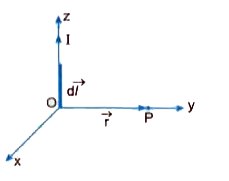Text Solution
Verified by Experts
|
Topper's Solved these Questions
MOVING CHARGES AND MAGNETISM
U-LIKE SERIES|Exercise LONG ANSWER QUESTIONS-I|33 VideosView PlaylistMOVING CHARGES AND MAGNETISM
U-LIKE SERIES|Exercise LONG ANSWER QUESTIONS-II|11 VideosView PlaylistMOVING CHARGES AND MAGNETISM
U-LIKE SERIES|Exercise VERY SHORT ANSWER QUESTIONS|39 VideosView PlaylistMODEL TEST PAPER 3 (UNSOLVED)
U-LIKE SERIES|Exercise SECTION A|3 VideosView PlaylistNUCLEI
U-LIKE SERIES|Exercise Self Assessment Test|10 VideosView Playlist
Similar Questions
Explore conceptually related problems
Knowledge Check
Similar Questions
Explore conceptually related problems
U-LIKE SERIES-MOVING CHARGES AND MAGNETISM -SHORT ANSWER QUESTIONS
- State Biot-Savart law. A current I flows in a conductor placed perpe...
Text Solution
|
Playing Now - A circular coil of radius R carries a curretn. Find an expression for ...
Text Solution
|
Play - (a) State Bio-Savart's law in vector form expressing the magnetic fiel...
Text Solution
|
Play - A long wire is first bent into a circular coil of one turn and then in...
Text Solution
|
Play - A straight wire of length L is bent into a semicircular loop. Use Biot...
Text Solution
|
Play - State Ampere's circuital law and express it mathematically. Give the s...
Text Solution
|
Play - State Ampere's circuital law, expressing it in the integral form.
Text Solution
|
Play - Explain how Biot-Savart's law enables one to express the Ampere's circ...
Text Solution
|
Play - State the principle of working of a cyclotron. Write two used of this ...
Text Solution
|
Play - A charge 'q' moving along the X-axis with a velociyt vecv (fig) is sub...
Text Solution
|
Play - A proton and a deuteron, each moving with velocity vecv, enter simulta...
Text Solution
|
Play - Two long coaxial insulated solenoids, S1 and S2 of equal lengths are w...
Text Solution
|
Play - A neutron , an electron and an alpha particle moving with equal veloci...
Text Solution
|
Play - Two long straight parallel conductors carrying currents I1 and I2 alon...
Text Solution
|
Play - A current loop is considered a magnetic dipole. Explain. Also give an ...
Text Solution
|
Play - A circular coil of N turns and radius R carries a current I. It is unw...
Text Solution
|
Play - A coil of N turns and radius R carries I . It is unwound and rewound t...
Text Solution
|
Play - Define current sensitivity and voltage sensitivity of a galvanometer. ...
Text Solution
|
Play - How do you convert a galvanometer into an ammeter ? Why is an ammeter ...
Text Solution
|
Play - Which one of the two , an ammeter or a milliammeter, has a higher resi...
Text Solution
|
Play
